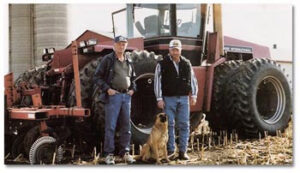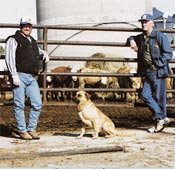 Keep Those Tractors Rolling
Keep Those Tractors Rolling
Petrolia, Ontario, Canada
Wayne (L) and Brian Gilroy
In the early development of Canada, the area south and east of Sarnia was one of the last parts of southern Ontario to be cleared and settled. Its heavy clay soil was difficult to plough and the land became almost impassable in rain. In the mid-1800s, however, people began to flock to Lambton County but with something other than agriculture on their minds. For years, the local native peoples had used a black, sticky substance seeping to the surface for medicinal and ritual purposes. The possibility of being the first to make a substantial oil discovery brought hundreds of fortune-seekers to the rough and ready frontier settlement of Oil Springs.
In 1858, James Miller Williams dug North America’s first commercial oil well and, four years later, the first gusher was struck. At the height of the boom, the oil fields surrounding Petrolia produced about 30,000 barrels of crude a day, most of which was transported by stagecoach and wagon over a plank road to the port of Sarnia some 40 kilometres (25 miles) distant.
At the present time, oil continues to be commercially pumped in small quantities from the fields around Petrolia by some 700 low-lying pump jacks. But it is agriculture that has become the dominant industry as farmers have tailored their cultivation practices to meet the challenges posed by the area’s heavy clay soils.
Wayne and Brian Gilroy — the Gilroy Brothers of Petrolia — are an example of a highly successful family farm operation. Together, they own three farms of 100 acres each (including the original home farm) and they rent or sharecrop an additional 1500 acres. “Our main business is a beef finishing operation,” says Wayne. “At the present time we have 500 head — mostly Hereford/Charolais crosses.” The Gilroys obtain most of their livestock from western Canada. “We generally get two semi-trailer loads shipped in each fall,” says Wayne.
The Gilroys fill most of their feed requirements from their own land. “We grow corn plus a lot of soya beans and some wheat. We’re situated on lake bottom clay here so we have to grow what grows above the ground and not under the ground!”
 No beefs with their equipment
No beefs with their equipment
Farming is a real family concern for the Gilroys since they handle all the chores themselves without the benefit of extra hands. Their way of life is clearly a passion which extends even into their leisure time activities. “About six years ago, my wife, Norma, started collecting toy tractors and other models of agricultural equipment,” says Wayne. “At the present time, we have around 500 items in our collection, including whole series of tractors such as the 66 Case International series.” Most of the models the Gilroys own are quite small; nonetheless, their display takes up one whole room of their house. “We fitted it out with more and more shelves as the collection grew,” says Wayne. “We used to keep all their boxes, the way serious collectors would, but storage got to be quite a problem. Now we just set them out on the shelves so we can enjoy them just as they are.”
The only preventative maintenance the Gilroys’ toy tractors require is an occasional flick with a duster. It’s quite another story for the six full size models they operate out in the field.
“We rely on Power Up to preserve everything — to make our equipment last. Just like everybody else we can’t afford any downtime. You only get to use most of your equipment a few weeks in the year and you need it to work for you when it counts most. It costs a lot of money to completely overhaul an engine and we’ve got some tractors around here with 5,000 hours on them.”
The Gilroys have been committed to the Power Up line of products since their Power Up representative first showed up in their laneway some five years ago. “We use Power Up in everything — tractors, trucks, cars, transmissions, gearboxes, whatever. Our combine runs completely on Power Up right down to the grease.”
Wayne doesn’t have a lot of time to keep statistics but he knows the product is working for him.
“I noticed a definite change in capacity when we started putting NNL 690G in the gearboxes of the combine and it continues to run more efficiently.” The Gilroys are also sold on the benefits of Thixogrease. According to Wayne, they haven’t lost a single bearing on their combine in five years’ use and you don’t need to be a statistician to figure out the value of that level of performance.
